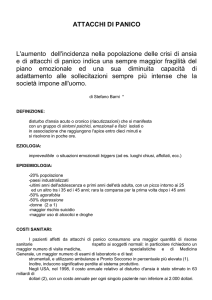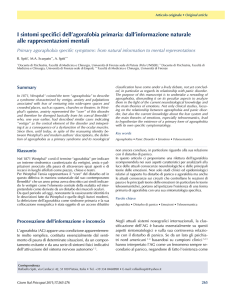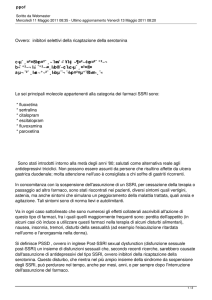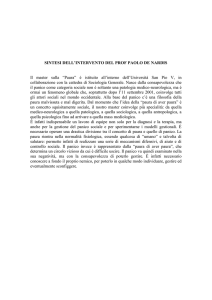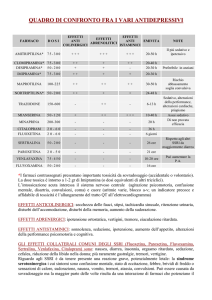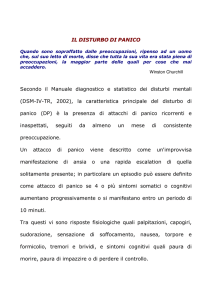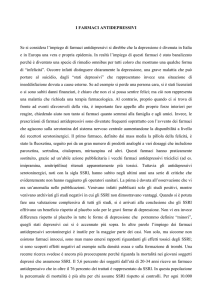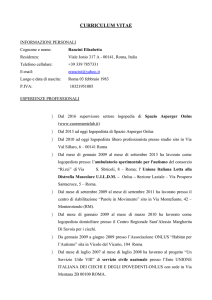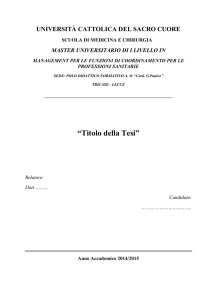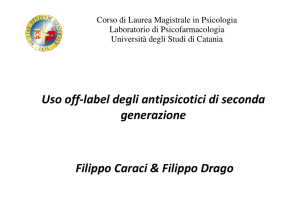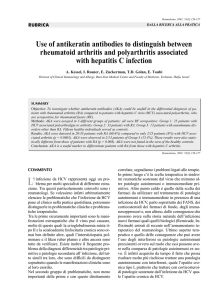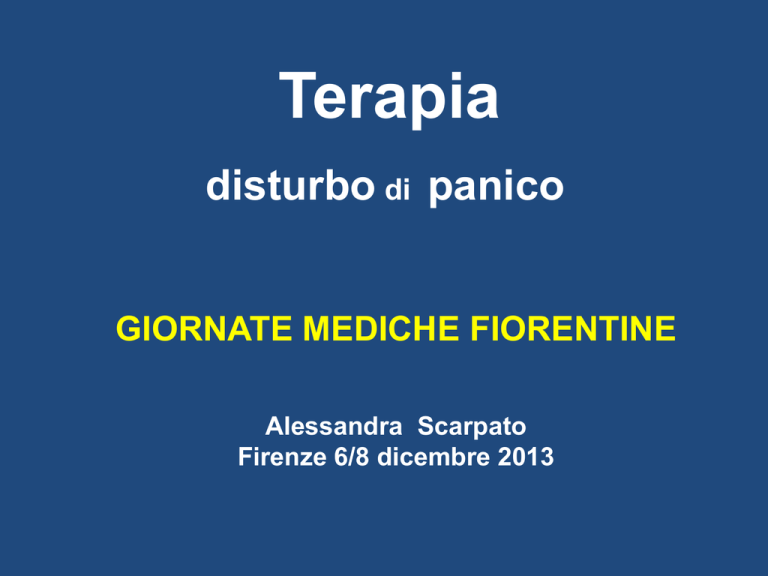
Terapia
disturbo di panico
GIORNATE MEDICHE FIORENTINE
Alessandra Scarpato
Firenze 6/8 dicembre 2013
Fattori che influenzano l’esito di una Terapia
1.
Efficacia del farmaco (per quella patologia);
2.
Dose del farmaco e durata del trattamento adeguati;
3.
Aspettative del medico e del paziente nei confronti della terapia;
4.
Fattori sociali e demografici;
5.
Caratteristiche di personalità del paziente;
6.
Andamento della terapia e sua ottimizzazione personalizzata;
7.
Aderenza al trattamento da parte del paziente: Compliance.
1Wheatley
D. Influence of doctors’ and patients’ attitudes in the treatment of neurotic illness. The Lancet, 1967, 2,
1133-1135.
DISTURBO DI PANICO
PARADOSSO
moltissime terapie efficaci
ma
esito delle terapie sostanzialmente insoddisfacente
Lo sviluppo della psicofarmacologia clinica
1949: Litio
1952: Antistaminici largactil, antipsicotici
Prima
1957: Antitubercolari IMAO
1958: Antipsicotici triciclici
1958: Sostanze inutili BDZ
1962: Clozapina tossica, ritirata
metodologia dei drug trial
Dopo
Antiepilettici stabilizzanti dell’umore
Clomipramina, SSRI antiossessivi
SSRI antiansia
Neurolettici atipici stabilizzanti dell’umore
Robert Spitzer
1978: Research Diagnostic Criteria, 1980:
DSM III
Donald Klein
1964: Acute, paroxysmal anxiety
Generalised, diffuse anxiety
DISTURBO di PANICO
CATEGORIE DI FARMACI CHE SI SONO DIMOSTRATI EFFICACI
IN PROVE CLINICHE CONTROLLATE
(double blind, placebo controlled)
CON
INDICAZIONE:
IMAO
TCA
SSRI
NSRI
BDZ
Disturbo di Panico
ALTRI FARMACI
mirtazapina
reboxetina
anticonvulsivanti
inositolo
-bloccanti ?
calcio antagonisti ?
trazodone ?
clozapina ?
olanzapina ?
Farmaci che si sono dimostrati inefficaci
Ritanserin
Maprotilina
Litio
CBT (Esposizione)
Ottimi risultati a breve e a lungo termine
moltissime
segnalazioni
Kilic et al., Psychother Psychosom, 1997
Fava et al., Psichol. Med., 2001
Ito et al., Br J Psychiatry 2001
Park et al., Br J Psychiatry 2001
Trattamento farmacologico del panico: reviews
Meta-analysis of 106 studies, pertaining to 222 treatment conditions, 5,011 patients : no
differences concerning panic attacks were found. For agoraphobic avoidance, the combination of
antidepressants with exposure in vivo was superior to the other conditions (van Balkom 1997)
Serotonin selective reuptake inhibitors offer benefits of ease of dosing, good tolerability, and no
safety or dependence problems; TCAs are often poorly tolerated, and benzodiazepines are
associated with dependence problems. (Davidson1998)
The "classic" MAOI (non-selective and irreversible) have a proven anti-panic effect. Selective
serotonin reuptake inhibitor (SSRI) anti-depressants are currently drugs of choice in the treatment
of Panic Disorder... . Benzodiazepines (BZD) .... have been shown to be effective in the treatment
of Panic Disorder. The major disadvantage of the BZD for this indication is related to the major
risk of promoting a dependency state with the corresponding appearance of a withdrawal syndrome
(Bougerol & Farisse,1996)
Acta Psychiatr Scand 2002 Sep;106(3):163-7
SSRIs vs. TCAs in the treatment of panic disorder: a metaanalysis.
Bakker A, Van Balkom AJ, Spinhoven P.
Objective: To compare the short-term efficacy of selective serotonin reuptake inhibitors (SSRIs) vs.
tricyclic antidepressants (TCAs) in the treatment of panic disorder (PD) a meta-analysis was
conducted. Method: Included were 43 studies (34 randomized, nine open), pertaining to 53 treatment
conditions, 2367 patients at pretest and 1804 at post-test. Outcome was measured with the proportion
of patients becoming panic-free, and with pre/post Cohen's d effect sizes, calculated for four clinical
variables: panic, agoraphobia, depression, and general anxiety. Results: There were no differences
between SSRIs and TCAs on any of the effect sizes, indicating that both groups of antidepressants are
equally effective in reducing panic symptoms, agoraphobic avoidance, depressive symptomatology
and general anxiety. Also the percentage of patients free of panic attacks at post-test did not differ.
The number of drop-outs, however, was significantly lower in the group of patients treated with
SSRIs (18%) vs. TCAs (31%). Conclusion: SSRIs and TCAs are equal in efficacy in the treatment
of panic disorder, but SSRIs are tolerated better.
Prognosi a lungo termine del DP:
Poor
Chronic agoraphobia
Chronic anxiety
Recurrent
Improvement
Full recovery
0
10
20
30
40
50
Fattori Predittivi Negativi
Lunga durata di malattia
Agorafobia
Depressione Maggiore
Disturbi di personalità
Altri disturbi d’ansia
Anxiety Sensitivity (paura di avere sintomi
d’ansia)
Trattamento farmacologico del panico: fattori che
influenzano la risposta
The presence of comorbidity results in more severe anxiety and depressive
symptoms, a higher rate of suicide attempts, a higher frequency of other
comorbid conditions, and a poorer response and compliance to treatment.
Thus, it is important for physicians to be aware of the possibility of comorbidity
in patients with panic disorder (Lecrubier 1998)
Comorbid generalized anxiety disorder, duration of illness, and phobic
avoidance behavior were found to be the best predictors of outcome
(Scheibe & Albus ,1997)
The patients with comorbid mood disorders and longer duration of illness
required higher doses of both drugs. The combined treatment of IMI and LRZ allowed
the use of low doses of the drugs, reduced the frequency and severity of the side
effects and improved patient compliance. (Marchesi et al, 1997)
Long duration and severe degree of symptoms at the initial assessment, as well
as coexistent depression are associated with a poor outcome (Kurz, 1996)
Psychopharmacol Bull 2001;35(2):97-110
Management of treatment-refractory panic disorder.
Mathew SJ, Coplan JD, Gorman JM.
Columbia University, College of Physicians and Surgeons, Department of Clinical
Psychobiology, New York State Psychiatric Institute
Treatment resistance remains a relatively common problem in panic disorder (PD). ….. For
patients who have not responded to one or more adequate trials of SSRIs, options include
combination treatment with a benzodiazepine or tricyclic antidepressant (TCA),
augmentation with pindolol, or switching to a different class of medication. The newer
antidepressants, particularly venlafaxine XR, seem promising as alternatives, and might be
beneficial for the refractory patient with a comorbid mood disorder. Anticonvulsants and
olanzapine might be particularly beneficial for the refractory patient with hypomania,
irritability, and insomnia, who also has demonstrated acute SSRI hypersensitivity.
Experimental therapeutics in refractory panic probably will continue to examine the role of
corticotropin releasing factor and glutamate/GABA systems. The role of CBT in the
medication refractory patient has been explored, with preliminary suggestions of efficacy .
ALGORITMO TERAPEUTICO
Diagnosi di DP
SSRI (paroxetina, sertralina, citalopram, fluvoxamina, fluoxetina)
o TCA (imipramina o clomipramina)
BDZ (alprazolam) per 20/40 giorni
Passare ad un altro SSRI o TCA
CBT: tecniche di esposizione e ristrutturazione cognitiva
Stabilizzatori dell’umore (Valproato, Gabapentin)
Am Fam Physician 2002 Oct 15;66(8):1477-84
What to do when SSRIs fail: eight strategies for optimizing treatment of panic
disorder.
Zamorski MA, Albucher RC.
University of Michigan Medical School, Ann Arbor, USA.
Selective serotonin reuptake inhibitors (SSRIs) are the drug of choice for treatment of patients with
panic disorder. Most patients have a favorable response to SSRI therapy; however, 30 percent will not
be able to tolerate these drugs or will have an unfavorable or incomplete response. Strategies to
improve management of such patients include optimizing SSRI dosing (starting at a low dose and
slowly increasing the dose to reach the target dose) and ensuring an adequate trial before switching to
a different drug. Benzodiazepines should be avoided but, when necessary, may be used for a short
duration or may be used long-term in patients for whom other treatments have failed. Slower-onset,
longer-acting benzodiazepines are preferred. All patients should be encouraged to try cognitive
behavior therapy. Augmentation therapy should be considered in patients who do not have a complete
response. Drugs to consider for use in augmentation therapy include benzodiazepines, buspirone, beta
blockers, tricyclic antidepressants, and valproate sodium.
La
letteratura
La clinica
Perché alcuni soggetti non rispondono ?
1 Non assumono la terapia
La clinica
2 Non tollerano la terapia
3 Non rispondono alle caratteristiche tipiche del DP
4 Veri non responders
“Il medico deve essere consapevole
del fatto che i pazienti, quando
affermano di avere preso taluni
medicamenti, spesso mentono !”
(Ippocrate)
Fattori che influenzano l’esito di una Terapia
Efficacia del farmaco
Dose del farmaco e durata del
trattamento adeguato
Aspettative del medico e del paziente
nei confronti della terapia
Fattori sociali e demografici
Caratteristiche di personalità del
paziente
Andamento della terapia e sua
ottimizzazione personalizzata
Compliance
PANIC DISORDER: associated personality disorders
•
DEPENDENT
12.3%
•
AVOIDANT
1.3%
•
HYSTRIONIC
2.4%
•
PARANOID
4%
•
OBSESSIVE-COMPULSIVE 3%
Mean of 5 studis
In medicina generale
cattiva o mancata aderenza: almeno il
30% dei pazienti
50% nelle patologie croniche
20% non acquista i farmaci
(Hayes et al 1979, Rashid 1982)
Come si valuta la mancata adesione ?
Metodo
Sensibilità
Chiedere al paziente
Chiedere a un familiare
30%
35%
Contare le pillole
Dosaggio ematico
60%
90%
(Porta 1994, modificato)
Pochi dati attendibili
I pazienti con Panico/agorafobia hanno
la più alta attrition rate di tutta la
patologia psichiatrica
2)
Non tollerano la terapia
Ipersensibilità e intolleranza agli
effetti collaterali
Disturbo di Panico
più effetti collaterali: iperattività autonomica
più intolleranti agli effetti collaterali: misinterpretazione
maggior timore di assuefazione/dipendenza
maggior necessità di controllo
FATTORI DI INTOLLERANZA
legati al tipo di paziente
legati al tipo ti farmaco
maggiore sensibilità
Peggioramento iniziale
necessità di controllo
effetti collaterali simili ai sintomi
ideologia ecologico-naturista
latenza di azione
sostenitori della psicogenesi
difficoltà obiettive (ingrassamento,
sex)
farmacofobia
“cenestofobia”
ipocondria
non accettazione della malattia
alternative realistiche (Psicoterapie)
Accorgimenti che favoriscono una buona
compliance
•Iniziare con dosaggi minimi, per poi salire gradualmente
•Spiegare al paziente che c’è un periodo di latenza di circa
tre/quattro settimane prima di percepire gli effetti terapeutici
somministrazione
•Preparare sempre il paziente a riconoscere e gestire gli eventuali
effetti collaterali
•Informarlo del possibile peggioramento temporaneo di alcuni dei
sintomi. In questa fase può risultare utile associare al trattamento di
base benzodiazepine per quattro/sei settimane.
Valutazioni di buon senso
Questo paziente QUI e ORA è in grado di accettare/sostenere la terapia che
prescriverei ?
SI
Si, a patto che…
NO
Attesa del paziente
Prescrizione teorica
Capacità di
veicolare la
prescrizione
Accettazione da parte del paziente
ALCUNE INFORMAZIONI UTILI di
SPETTRO:
• Viaggia da solo o rimane da solo senza disagio
• Prova fastidio in condizioni climatiche avverse
• Ha mai temuto o evitato di assumere farmaci prescritti
• Legge i bugiardini
• Usa le cinture di sicurezza
• Cravatte collane maglioni a collo alto
PAS-SR
• Nuota con la testa sotto
• Ha mai eseguito esami non consigliati dal suo
medico
• Porta spesso con se una bottiglietta di acqua
• Si e mai seduto vicino all’ uscita al cinema o in
chiesa
• Può stare senza cellulare
• Ha mai avuto il bisogno di avere amici medici
PAS-SR
2 strategie terapeutiche
Obiettivo = scomparsa
dei sintomi
Obiettivo =
padroneggiamento dei
sintomi
dosaggi alti, tali da
mantenere i sintomi
totalmente silenti
dosaggi tali da
consentire l’emergere di
sintomatologia
controllabile
Modello integrato psicoterapia e farmacoterapia.
3 posizioni:
Pt + farmaci > ai due trattamenti singoli
Pt + farmaci = Pt > farmaci
Pt + farmaci < Pt da sola
BUONSENSO e
ATTENZIONE
Capacita di ascoltare i bisogni personalizzati del paziente
Conoscenza delle diverse sfumature recettoriali che fanno la
differenza fra farmaci di una stessa famiglia
Poter stabilire un buon rapporto fiduciario medico paziente

